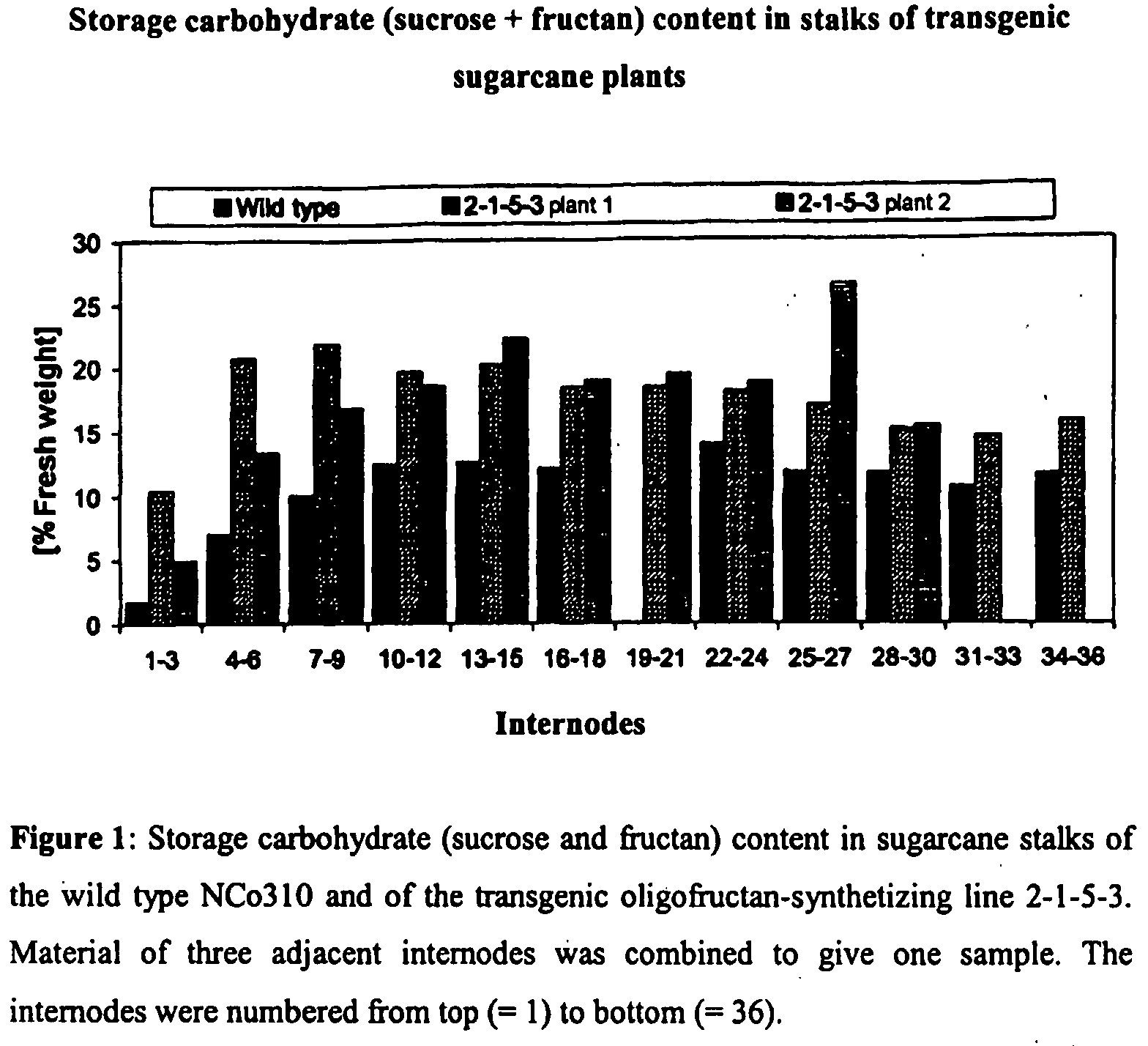Sugarcane Plants with an Increased Storage Carbohydrate Content
a technology of sugarcane and storage carbohydrate, which is applied in the direction of enzymology, organic chemistry, transferases, etc., can solve the problems of time-consuming and labor-intensive procedures, and achieve the effect of increasing the expression of arabidopsis and elevating the expression of plants
- Summary
- Abstract
- Description
- Claims
- Application Information
AI Technical Summary
Benefits of technology
Problems solved by technology
Method used
Image
Examples
example 2
Transgenic Sugarcane Plants Transformed With the 1-sst Gene From Artichoke (Cynara scolymus) (pML1 Plants)
[0150]2.1 Materials and methods
[0151]Sugarcane plants of the line NCo310 were transformed with the artichoke sst gene as described in Example 1 by means of particle gun bombardment. Transgenic sugarcane plants of the oligofructan-synthetizing line 2-1-5-3 and the wild-type line NCo310 were grown in the greenhouse. Stalks were harvested from approximately 12-month old plants. After removal of the leaves, the internodes of the stalk were numbered from top (=1) to bottom (for example=36). A stalk disc approximately 1-2 g in weight was excised from the middle of each internode. The stalk discs of 3 internodes were combined to give one sample and frozen.
[0152]The method described in greater detail in the methodology section was employed for the extraction of sugar and fructan.
[0153]2.2 Results
[0154]Sugarcane plants cv. NCo310 which had been transformed with the artichoke sst gene and...
example 3
Generation of Transgenic Sugarcane Plants Which Express a 1-sst Gene and a 1-fft Gene From Artichoke (Cynara scolymus) (pML2 Plants)
[0158]The vector pML11 which has been described in Example 1 was used as basic vector for cloning the construct comprising the 1-sst and the 1-fft from artichoke.
[0159]1. Expression cassette for the 1-fft gene
[0160]An NotI fragment from pCy3 comprising the open reading frame of the Cynara scolymus fructan-fructan 1-fructosyl transferase (fft) (Hellwege et al., FEBS Lett. 427, 1998, 25-28; Accession number AJ000481.2) was cloned into the vector pML8 (see Example 1). The resulting plasmid was named pML9.
[0161]2. Final vector
[0162]The vector pML11 was cut with NheI and ligated to a 3877 bp NheI fragment from pML9. The NheI fragment from pML9 was obtained by a partial digest and comprises the complete expression cassette for 1-fft (ubiquitin promoter, ubiquitin intron, open reading frame for fft and nos terminator). In the resulting vector, the 1-fft casset...
example 4
Transgenic Sugarcane Plants Transformed With the 1-sst and the 1-fft Gene From Artichoke (pML2 Plants)
[0163]1.1 Materials
[0164]The transgenic sugarcane plants which had been generated as described in Example 3 and which express both the 1-SST and the 1-FFT gene from Cynara scolymus were grown in the greenhouse for 12 months. In each case one sugarcane stalk of the transgenic line 1-2-3-3 and a wild-type sugarcane plant was defoliated, the stalk was divided into segments of 3 internodes, and these internode segments were frozen in liquid nitrogen in a sealed 50 ml plastic container. The fresh weight of the samples was determined. The extraction for the purposes of the fructan and sugar determination was as described in the methodology section.
[0165]1.2 Results
[0166]The sugarcane stalks were divided into segments of in each case three internodes, as specified above. The internodes were numbered from top to bottom (top=internode 1, bottom=internode 21).
[0167]In the sugarcane wild-type ...
PUM
| Property | Measurement | Unit |
|---|---|---|
| Carbohydrate content | aaaaa | aaaaa |
Abstract
Description
Claims
Application Information
 Login to View More
Login to View More - R&D
- Intellectual Property
- Life Sciences
- Materials
- Tech Scout
- Unparalleled Data Quality
- Higher Quality Content
- 60% Fewer Hallucinations
Browse by: Latest US Patents, China's latest patents, Technical Efficacy Thesaurus, Application Domain, Technology Topic, Popular Technical Reports.
© 2025 PatSnap. All rights reserved.Legal|Privacy policy|Modern Slavery Act Transparency Statement|Sitemap|About US| Contact US: help@patsnap.com


